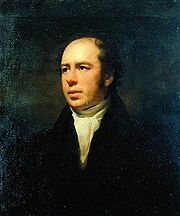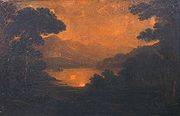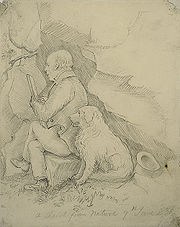
Reverend John Thomson
Encyclopedia



Duddingston Kirk
Duddingston Kirk is a Parish Church in the Church of Scotland, located adjacent to Holyrood Park in Duddingston Village, on the east side of the City of Edinburgh. Regular services are held at the Kirk, conducted by the minister, Rev Dr James A. P...
near Edinburgh
Edinburgh
Edinburgh is the capital city of Scotland, the second largest city in Scotland, and the eighth most populous in the United Kingdom. The City of Edinburgh Council governs one of Scotland's 32 local government council areas. The council area includes urban Edinburgh and a rural area...
, Scotland
Scotland
Scotland is a country that is part of the United Kingdom. Occupying the northern third of the island of Great Britain, it shares a border with England to the south and is bounded by the North Sea to the east, the Atlantic Ocean to the north and west, and the North Channel and Irish Sea to the...
and a distinguished amateur landscape
Landscape art
Landscape art is a term that covers the depiction of natural scenery such as mountains, valleys, trees, rivers, and forests, and especially art where the main subject is a wide view, with its elements arranged into a coherent composition. In other works landscape backgrounds for figures can still...
painter
Painting
Painting is the practice of applying paint, pigment, color or other medium to a surface . The application of the medium is commonly applied to the base with a brush but other objects can be used. In art, the term painting describes both the act and the result of the action. However, painting is...
.
Early life
The youngest of eight children, Thomson was born in DaillyDailly
Dailly is a village in South Ayrshire, Scotland. It is located on the Water of Girvan, south of Maybole, and east of Old Dailly. "New Dailly", as it was originally known, was laid out in the 1760s as a coal-mining village...
, Ayrshire
Ayrshire
Ayrshire is a registration county, and former administrative county in south-west Scotland, United Kingdom, located on the shores of the Firth of Clyde. Its principal towns include Ayr, Kilmarnock and Irvine. The town of Troon on the coast has hosted the British Open Golf Championship twice in the...
, the fourth son of the local parish minister. From an early age, he displayed an aptitude for drawing and painting and, inspired by the Ayrshire countryside, developed a love for landscape painting. In 1791 he enrolled at Glasgow University
University of Glasgow
The University of Glasgow is the fourth-oldest university in the English-speaking world and one of Scotland's four ancient universities. Located in Glasgow, the university was founded in 1451 and is presently one of seventeen British higher education institutions ranked amongst the top 100 of the...
to study law
Law
Law is a system of rules and guidelines which are enforced through social institutions to govern behavior, wherever possible. It shapes politics, economics and society in numerous ways and serves as a social mediator of relations between people. Contract law regulates everything from buying a bus...
and theology
Theology
Theology is the systematic and rational study of religion and its influences and of the nature of religious truths, or the learned profession acquired by completing specialized training in religious studies, usually at a university or school of divinity or seminary.-Definition:Augustine of Hippo...
, and in 1793 he transferred to Edinburgh University
University of Edinburgh
The University of Edinburgh, founded in 1583, is a public research university located in Edinburgh, the capital of Scotland, and a UNESCO World Heritage Site. The university is deeply embedded in the fabric of the city, with many of the buildings in the historic Old Town belonging to the university...
to continue his studies for the ministry. Whilst there, he met many people who were prominent in Edinburgh artistic circles, including Sir Walter Scott
Walter Scott
Sir Walter Scott, 1st Baronet was a Scottish historical novelist, playwright, and poet, popular throughout much of the world during his time....
, and Alexander Nasmyth
Alexander Nasmyth
Alexander Nasmyth was a Scottish portrait and landscape painter, often called the "father of Scottish landscape painting".-Biography:...
, the latter of whom who gave him art lessons.
After graduating, Thomson returned to Ayrshire and was licensed as a preacher
Preacher
Preacher is a term for someone who preaches sermons or gives homilies. A preacher is distinct from a theologian by focusing on the communication rather than the development of doctrine. Others see preaching and theology as being intertwined...
of the Gospel
Gospel
A gospel is an account, often written, that describes the life of Jesus of Nazareth. In a more general sense the term "gospel" may refer to the good news message of the New Testament. It is primarily used in reference to the four canonical gospels of Matthew, Mark, Luke, and John...
, and subsequently ordained as minister of Dailly in 1800. He later moved to Duddingston
Duddingston
Duddingston is a former village in the east of Edinburgh, Scotland, next to Holyrood Park.-Origins and etymology:The estate wherein Duddingston Village now lies was first recorded in lands granted to the Abbot of Kelso Abbey by David I of Scotland between 1136–47, and is described as stretching...
near Edinburgh and became the most famous minister of the local Kirk
Kirk
Kirk can mean "church" in general or the Church of Scotland in particular. Many place names and personal names are also derived from it.-Basic meaning and etymology:...
, holding the post from 1808 to 1840. Whilst at Duddingston a very fine portrait of him was painted by Robert Scott Lauder
Robert Scott Lauder
Robert Scott Lauder was a Scottish mid-Victorian artist who described himself as a "historical painter". He was one of the original members of the Royal Scottish Academy.-Life and work:...
.
Later career
Thomson had a studio at the foot of the manse garden on the shore of Duddingston Loch. Later, this was replaced by Duddingston Tower, a structure designed for Duddingston Curling Society in 1825 by William PlayfairWilliam Henry Playfair
William Henry Playfair FRSE was one of the greatest Scottish architects of the 19th century, designer of many of Edinburgh's neo-classical landmarks in the New Town....
. The Society used the ground floor as their clubhouse, and Thomson used the upper floor of the tower, known today as "Thomson's Tower", as his studio.
The move to Duddingston allowed him to renew his acquaintances with men of influence in artistic circles and develop his art. Like his early teacher, Naysmith, Thomson believed in working outdoors, observing directly from nature. Influenced by the techniques of Rosa
Salvator Rosa
Salvator Rosa was an Italian Baroque painter, poet and printmaker, active in Naples, Rome and Florence. As a painter, he is best known as an "unorthodox and extravagant" and a "perpetual rebel" proto-Romantic.-Early life:...
, Lorrain
Claude Lorrain
Claude Lorrain, , traditionally just Claude in English Claude Lorrain, , traditionally just Claude in English (also Claude Gellée, his real name, or in French Claude Gellée, , dit le Lorrain) Claude Lorrain, , traditionally just Claude in English (also Claude Gellée, his real name, or in French...
, Poussin
Nicolas Poussin
Nicolas Poussin was a French painter in the classical style. His work predominantly features clarity, logic, and order, and favors line over color. His work serves as an alternative to the dominant Baroque style of the 17th century...
, Raeburn
Henry Raeburn
Sir Henry Raeburn was a Scottish portrait painter, the first significant Scottish portraitist since the Act of Union 1707 to remain based in Scotland.-Biography:...
and renowned English landscape artist Turner
J. M. W. Turner
Joseph Mallord William Turner RA was an English Romantic landscape painter, watercolourist and printmaker. Turner was considered a controversial figure in his day, but is now regarded as the artist who elevated landscape painting to an eminence rivalling history painting...
, he developed a broad Romantic
Romanticism
Romanticism was an artistic, literary and intellectual movement that originated in the second half of the 18th century in Europe, and gained strength in reaction to the Industrial Revolution...
style, and became a landscape artist with an established reputation. This allowed him to augment his small stipend
Stipend
A stipend is a form of salary, such as for an internship or apprenticeship. It is often distinct from a wage or a salary because it does not necessarily represent payment for work performed, instead it represents a payment that enables somebody to be exempt partly or wholly from waged or salaried...
and become quite wealthy through the sale of his paintings.
In addition to Scott, Naysmith and Raeburn, Thomson was friendly with writer and fellow amateur artist, Sir Thomas Dick Lauder
Thomas Dick Lauder
Sir Thomas Dick Lauder of Fountainhall, 7th Baronet, FRSE FSA was a Scottish author. He served as Secretary to the Board of Manufactures , on the Herring Fisheries Board, at the Royal Institution for the Encouragement of the Fine Arts, and as Deputy Lieutenant of both counties of Moray and...
, and such was Thomsons reputation that in 1818 he entertained Turner at his studio, who is said to have remarked of the outlook over the Loch: "By God sir, I envy you that piece of water." Thomson went on to collaborate with Turner in producing engravings to illustrate Walter Scott's Provincial Antiquities and Picturesque Scenery of Scotland, published in 1826.
Recognising his talent, Thomson's congregation nominated him to become a member of the Association of Artists in Edinburgh. He went on to receive honorary memberships of the Royal Institution for the Encouragement of the Fine Arts in Scotland and the Royal Scottish Academy
Royal Scottish Academy
The Royal Scottish Academy is a Scottish organisation that promotes contemporary Scottish art. Founded in 1826, as the Royal Institution for the Encouragement of the Fine Arts, the RSA maintains a unique position in Scotland as an independently funded institution led by eminent artists and...
. Thomson died at Duddingston in 1840, having spent forty-one years in the ministry.
Anecdotes
- In addition to being known for his landscape paintings, Thomson is often credited with giving rise to the famous Lowland ScotsScots languageScots is the Germanic language variety spoken in Lowland Scotland and parts of Ulster . It is sometimes called Lowland Scots to distinguish it from Scottish Gaelic, the Celtic language variety spoken in most of the western Highlands and in the Hebrides.Since there are no universally accepted...
adageAdageAn adage is a short but memorable saying which holds some important fact of experience that is considered true by many people, or that has gained some credibility through its long use....
"We’re a' Jock Tamson’s bairnsJock Tamson's Bairns"We're a' Jock Tamson's Bairns" is Lowland Scots and Northumbrian English for we're all John Thomson's children, It is a popular saying in Scotland and the far north of England, and is known in other parts of the world...
", which as early as 1847 was described as "an expression of mutual good fellowship very frequently heard in Scotland." However, there is some evidence that it may predate John Thomson, and there is also a Scottish Gaelic version.
- One version attributing the origin of the adage to Thomson is that his first wife died after they had five children, he then married a widow who already had five children, and this second marriage produced another four children. When his wife then made introductions to visitors and tried to explain which family the various children belonged to, Thomson would interrupt her with the statement that "They're a' Jock Thomson's bairns".
- To ensure privacy to paint in his studio, Thomson named the Tower "Edinburgh", in order that casual visitors to the Manse could be informed by his staff that he was unavailable, as he had gone to "Edinburgh".
- Duddingston Loch has a long historical connection with curlingCurlingCurling is a sport in which players slide stones across a sheet of ice towards a target area. It is related to bowls, boule and shuffleboard. Two teams, each of four players, take turns sliding heavy, polished granite stones, also called "rocks", across the ice curling sheet towards the house, a...
and skatingIce skatingIce skating is moving on ice by using ice skates. It can be done for a variety of reasons, including leisure, traveling, and various sports. Ice skating occurs both on specially prepared indoor and outdoor tracks, as well as on naturally occurring bodies of frozen water, such as lakes and...
and is the setting for the iconic painting, The Skating MinisterThe Skating MinisterThe Reverend Robert Walker Skating on Duddingston Loch, better known by its shorter title The Skating Minister, is an oil painting by Sir Henry Raeburn in the National Gallery of Scotland in Edinburgh. It was practically unknown until about 1949; today, however, it is one of Scotland's best known...
, by Thomsons artistic acquaintance, Sir Henry Raeburn. The subject of the painting is not Thomson however, but the Reverend Robert Walker, minister of the Canongate KirkKirk of the CanongateThe Kirk of the Canongate, or Canongate Kirk, serves the Parish of Canongate in Edinburgh's Old Town, in Scotland. It is a congregation of the Church of Scotland. The parish includes the Palace of Holyroodhouse and the Scottish Parliament. It is also the parish church of Edinburgh Castle, even...
.

